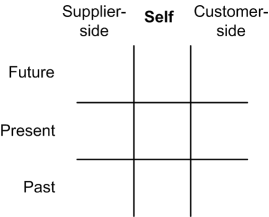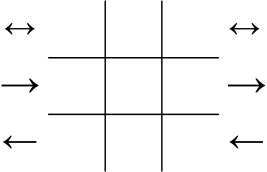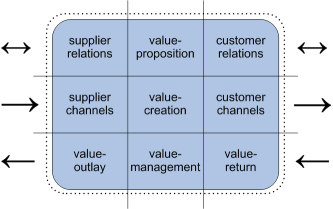The Enterprise Canvas: a Really Simple Summary
The full Enterprise Canvas model is a complex beast, with many ideas, many layers, many ramifications and side-themes: it can perhaps seem daunting at first. Yet when we strip it right down to its bare essentials, it’s actually very simple indeed – and its real power comes from that underlying simplicity. So here’s a Really Simple Summary of the ideas behind the Enterprise Canvas:
Everything in the enterprise is a service.
The Enterprise Canvas is a generic map to describe any service, anywhere in the enterprise, together with its interdependencies and flows.
The Enterprise Canvas therefore provides a consistent means to model anything, anywhere in the enterprise.
To give a bit more detail, to make that Really Simple Summary more usable in practice:
Everything exists within one infinite ecosystem, which we might label ‘the universe’.
For practical reasons – and for sanity’s sake – we usually restrict our view to a much smaller subset of that ‘the everything’. (We do always need to remember that it actually is ‘the everything’, though.)
One useful option, especially for organisations, is to select the subset that describes that part of the ecosystem within which the organisation operates. This ‘extended-enterprise’ (or ‘enterprise’, for short) is always larger than the organisation itself, and coalesces around a single idea or descriptor, usually referred to as the ‘vision’ for the enterprise.
Within that enterprise, we assert that every entity represents a service.
Every entity delivers services, provides services, consumes other services. The ecosystem is made viable by this constant interchange of services.
This interchange occurs at every level. Everything is a service, from whole organisations to the faucet in the bathroom or a single line of program-code.
Everything is a service.
For each entity, it can be useful to divide the view into three partitions, in terms of role and relationship: the role, function and services of the entity itself; its relationships with the entities that provide the services that this entity consumes (‘supplier-side’); and its relationships with the entities that consume the services that this entity provides (‘customer-side’).
For each entity, it can also be useful to divide the view into three other partitions, in terms of time: what is intended to happen (‘future’); what is actually happening (‘present’); and what has happened (‘past’).
These two sets of views are orthogonal to each other. We can therefore map this as a three-by-three matrix:
The relationships with other entities are symmetrical in the sense that every entity shares the same pattern: the only difference between ‘supplier-side’ and ‘customer-side’ is the main direction of service-flow relative to the entity that is our current focus of attention.
The ‘future’-oriented relationships are essentially peer-to-peer, and bidirectional.
The ‘present’-oriented relationships are mainly about ‘supply-chain’ transfer of goods and services from supplier to self, or self-to customer (i.e. left-to-right on the Canvas).
The ‘past’-oriented relationships are mainly about balancing the supply-chain transfer via a ‘backchannel’ from customer to self, and self to supplier (i.e. right-to-left on the Canvas).
We can thus describe the overall entity in terms of nine subsidiary ‘cells’ or sets of related activities:
- supplier-side/future: build and maintain relationships with potential and/or actual ‘supplier’ service-provider entities, about things that need to happen in the future – supplier-relations
- supplier-side/present: receive goods and/or services from ‘supplier’ entities – supplier-channels
- supplier-side/past: provide balance or compensation to ‘supplier’ entities (e.g. pay for goods) – value-outlay
- self/future: identify what this entity will do and deliver, aligned to the overall enterprise purpose and values – value-proposition
- self/present: take all actions necessary to create and deliver the goods and/or services specified in the value-proposition – value-creation
- self/past: ensure the appropriate functioning of the overall entity, balancing past, present and future – value-management
- customer-side/future: build and maintain relationships with potential and/or actual ‘customer’ service-consumer entities, mainly about what should happen in the future – customer-relations
- customer-side/present: deliver goods and/or services to ‘customer’ entities – customer-channels
- customer-side/past: receive balance or compensation from ‘customer’ entities (e.g. payment for goods) – value-return
Each of these ‘cells’ delivers its own services to the entity, and could thus, recursively, be represented by and described on its own Enterprise Canvas.
Each entity may be described in terms of various layers on a spectrum between most-abstract (the enterprise as a whole) to most-concrete (the detailed-past).
Note that ultimately all boundaries are arbitrary, and in most cases exist for descriptive and/or administrative convenience only. Within the overall ecosystem, any or all of its services may be recombined and reconfigured in an infinity of alternate ways. The key criterion for success is not ‘correctness’, but effectiveness:
- efficient: optimises use of resources, minimises wastage of resources
- reliable: predictable, consistent, self-correcting, supports ‘single source of truth’ etc
- elegant: clarity, simplicity, consistency, self-adapting for human factors
- appropriate: supports and optimises support for business purpose
- integrated: creates, supports and optimises synergy across all systems
Effectiveness occurs when everything supports everything else, all the way up to the enterprise vision or purpose.
The Enterprise Canvas does not attempt to describe every aspect of every service. Its role is to provide a consistent base-frame to link descriptions together into a unified whole. It would generally be used in conjunction with many other model-types, for example:
- use VPEC-T to model each of the flows to and from the entity in focus
- use modified-Zachman to model the assets, functions, locations, capabilities, events and decisions in each flow, in each cell and in the entity as a whole
- use SWOT to assess strengths, challenges, opportunities and risks in each flow, cell and entity
The Enterprise Canvas will also work well with other techniques for SOA (service-oriented architecture) and any other cross-enterprise concerns such as quality, security, safety and environment.
There’s a lot more to it than just the above, of course, but I hope this ‘really simple summary’ will give you enough to get started?



Leave a Reply